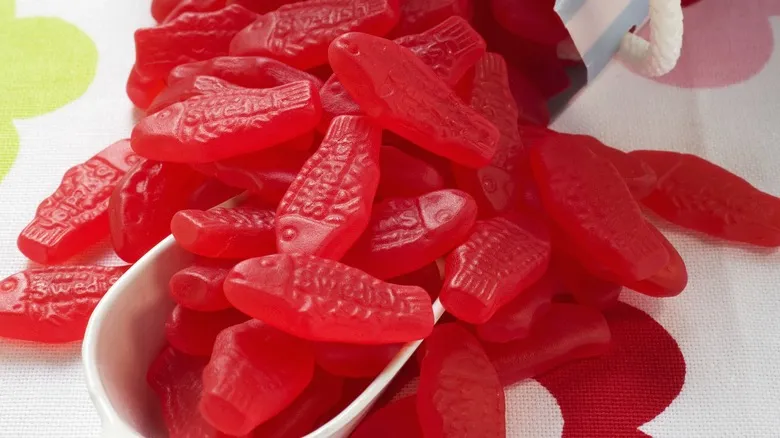The unusual lingonberry candy

A lingonberry is a small, vibrant red fruit that grows in clusters and is closely related to the similarly red cranberry and the less red blueberry. Its flavor is a combination of tartness and mild sweetness, reminiscent of cranberries. Due to their acidic profile, lingonberries are often sweetened with sugar or other sweeteners before consumption. While they can be found across North America, they are more popular and widely used for flavoring in Europe, particularly in Scandinavia. For instance, the affordable Swedish meatballs served at IKEA often come with a side of lingonberry jam.
So, how do we know that Swedish Fish are flavored with lingonberry? It's somewhat speculative, but those familiar with lingonberries tend to believe that the flavors are similar enough, especially given the fruit's popularity in Sweden. The red gummy candies exhibit a comparable blend of tart and sweet notes, although the American version is even sweeter and has altered flavoring compared to the original Swedish recipe, which uses slightly different ingredients. However, there is some uncertainty—Americans who are more accustomed to cherries than lingonberries might insist that Swedish Fish taste like cherry, suggesting that the flavor could be a blend of various berries.
How Swedish Fish swam onto shelves

It doesn't make things easier that there are numerous other Swedish Fish flavors available today, apart from the potentially lingonberry "red flavor." You can find mixed packs featuring red, yellow, orange, and green Swedish Fish, each with its own distinct taste. There's a general agreement that the orange ones are indeed orange-flavored, the yellow ones are lemon, and the green ones are lime (though some argue they taste like pineapple). Additionally, there are "tropical" Swedish Fish bags, which clearly state their flavors as piña colada, tropical island, beachy punch, and passion fruit.
These are just the flavors available in the U.S. In Sweden, Malaco, the original creators of Swedish Fish, produces a black licorice-flavored version. Based in Malmö, southern Sweden, Malaco first introduced these candies in the 1950s with the American market in mind. The Swedish variant is often referred to as "pastellfiskar," meaning "pastel fish," and features "Malaco" printed on the sides instead of the word "Swedish" found on the American version. All Swedish Fish are classified as wine gums (a chewy candy that contains no wine), making them light enough to serve as excellent toppings for frozen yogurt, and they have a distinctly fruity flavor, even if the specific fruit is hard to identify.
Recommended

Custard Vs Soft Serve Ice Cream: What's The Difference?

Why You Can Revive Fruitcake That's Been Sitting For Years

The No-Fail Blender Method For Quick, Easy Hollandaise Sauce

Here's How Long Orange Juice Stays Fresh After Opening
Next up

